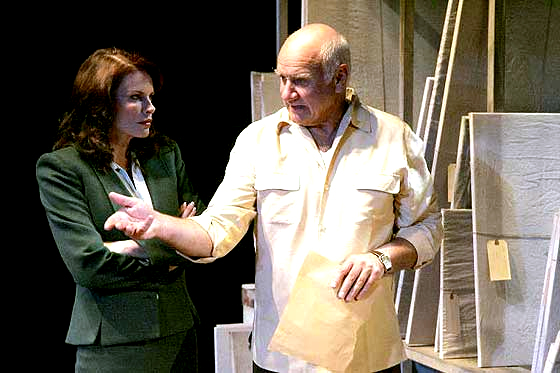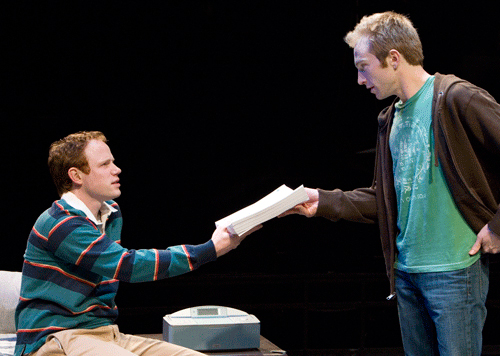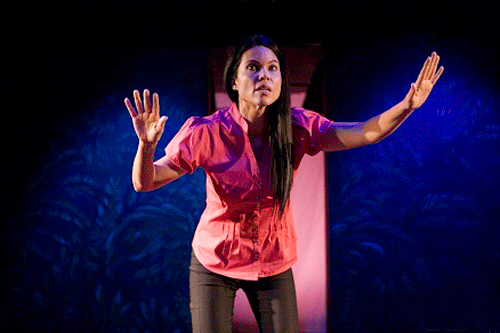FEBRUARY 2007
Click title to jump to review
A PICASSO by Jeffrey Hatcher | Geffen Playhouse
DEFIANCE by John Patrick Shanley | Pasadena Playhouse
THE FOUR OF US by Itamar Moses | The Old Globe
JAMAICA, FAREWELL by Deborah Ehrhardt | Whitefire Theater
THE MARVELOUS WONDERETTES by Roger Bean | El Portal Forum Theatre
THE PURSUIT OF HAPPINESS by Richard Nelson | Laguna Playhouse
SPEED-THE-PLOW by David Mamet | Geffen Playhouse
WHO'S AFRAID OF VIRGINIA WOOLF? by Edward Albee | Ahmanson Theatre
Re-generative art
In A Picasso, continuing at L.A.’s Geffen Playhouse through March 25, playwright Jeffrey Hatcher takes us to conflicted Vichy France, where a society renowned for fostering artistic freedom was suddenly under the boot of a paranoid culture at its most oppressive.
From 1940 until 1944, France was divided into an area occupied by Nazi Germany and one administered by the hastily devised Vichy-based French government, which collaborated with the Germans. Paris, in the occupied section, is the setting for this fictional face-off between Pablo Picasso, played by Peter Michael Goetz, and a less-than-committed German official named Ms. Fischer, played by Roma Downey. Through these two, Hatcher provides sketches of censorship at its most insane and unjust, and a creative genius at his most embattled.

In its mad rush to brainwash people into agreement, the Nazi propaganda machine not only generated sanctioned "art" that promoted its narrow racial profile, it set about discrediting and destroying "degenerative art," Entartete Kunst as they called it. Cowed and genocidal as they became, many Germans were nevertheless highly educated and culturally advanced. Deep within the officious, dispassionate Ms. Fischer, a pilot light still flickers with appreciation for the creative breakthroughs and historic achievements that had emerged in this city before Hitler’s rise.
Geffen Producing Director Gilbert Cates directs this West Coast premiere in the Playhouse’s smaller Audrey Skirball Kenis Theater, configured with seating on opposite sides of a central playing area. An imaginative set by François-Pierre Couture sits like a huge, shuttered newspaper stall one might find in a subway. Replicas of the Entartete Kunst paintings adorn chain link that clings to the sidewalls of the auditorium. Ms. Downey, looking every inch the ‘40s screen siren, enters through a doorway dressed up as an elevator and, in clipped steps, approaches the vault-like cube. With the press of a button she puts the large metal roll-up doors in motion, raising a foreboding curtain and revealing a simple underground room with shelves, files and a central interrogation table and chairs.
Out of respect for the seriousness of the situation, Cates has kept the actors’ exchanges doggedly earnest and devoid of playfulness. The solid Goetz gives Picasso the stature and hubris we would expect, but he seems restrained from letting the renowned womanizer expose what – even in this situation – should be an irrepressible desire to charm a woman of Fischer’s beauty. The script, in fact, will reveal that there is even more cause for magnetism between these two. A hint of the tugging that is working within each of them – without being overly demonstrative -- might add dimension to the scenes before the connection is called for by the text. Perhaps Cates feels flirtation and seduction are out of place with the stakes so high. A famous man used to his own powers of attraction, however, would not only see this as a viable tact, he would be incapable of resisting it before the alluring Ms. Downey. It’s a drive that trumps – or in some cases incorporates – defiance and self-righteousness. As the stern representative of the Third Reich, Ms. Downey appropriately masks her character’s feelings. However, it may be too tight a mask given what she is hiding.
Nevertheless, this remains an entertaining – if, at 75 minutes, brief – evening. Hatcher’s plot is a good device to get a artist talking about his work, both for the imagined self-interpretation from the master and for the reminder of the crime against nature that is committed when artists are forced to justify their creativity.
On the real side: For Roma Downey’s entrance in Hatcher’s cat-meets-mouse, cat-loses-mouse, mouse-paints-cat into a corner drama, a door in one of the Audrey Skirball-Kenis Theater walls is made to look like an elevator door. Above the door, an arrow moves to indicate the floor where the elevator has stopped. To Jon Gottlieb's sound cue, the arrow shows the elevator rise a floor and then return, allowing Ms. Downey to emerge. The fact that all this effort was made, despite the fact that sightlines restrict all but a dozen people from seeing it, is one of the reasons you got to love theater. posted February 22, 2007
top of page
A PICASSO
by JEFFREY HATCHER
directed by GILBERT CATES
GEFFEN PLAYHOUSE
February 4-March 18, 2007
Opened February 11
CAST Roma Downey, Peter Michael Goetz
PRODUCTION François-Pierre Couture, set; Christina Haatainen Jones, costumes; Daniel Ionazzi, lights; Jon Gottlieb, sound; Amy E. Bristol, stage management
HISTORY West Coast Premiere
Roma Downey, Peter Michael Goetz
Michael Lamont
On the offensive
The West Coast premiere of John Patrick Shanley’s ‘Defiance,’ continuing through February 18, promises an evening of testosterone-fueled pyrotechnics. For the follow-up to Shanley’s Tony awarded and Pulitzer-winning ‘Doubt,’ the action moves from Catholic school to military base and from passive suspicion to outright resistance. But insuring an explosive delivery of what is reported to be the second part of a trilogy is the presence of Andrew J. Robinson as director and a formidable cast. With the offstage Robinson twisting at one end and Kevin Kilner, Robert Manning Jr., Leo Marks, Joel Polis, Dennis Flanagan and the formidable, lone woman Jordan Baker twisting from onstage, they wring the tension out this script like sweat from a towel.
The setting is 1971, two years before Roe v Wade and three after the King and RFK assassinations. The Vietnam War was in full swing; the invasion into Cambodia and Kent State killings had happened the previous spring. Every great ‘60s rights and anti-war movement, as well as the questioning of the church’s authority, were roiling away on America’s front burners. In an intermissionless 90 minutes, Shanley divvies up both sides of all these issues to just a handful of characters who approach their positions in a range of personalities from believers or non, lost or committed, and those living on hold versus those in denial. The economy of the dramaturgy presents the challenge for the capable cast, who must often turn on a dime in order to move from one battlefield to the next.
John Iacovelli’s set easily shifts from the corrugated Quonset feel of the base offices to the cramped, spot-on ‘70s décor of the base housing of Colonel Littlefield (Kilner) and his wife (Baker). After all the religious, racial, military and marital issues have been worked over, it is here in the Littlefield home that inaction – one spouse in deference, the other in denial– become more important than either defiance or doubt.
And this is where the play feels less than fulfilling, even though that is exactly how it must be left. Whether Baker can come up with enough appropriate energy to counter-balance Kilner’s properly stoic Colonel is the key, and not an easy one to turn. She must trod a line between the dutiful wife who is ready to smote her husband when he gets out of line. It's her defiance that really matters, and many who grew up in those years did so under these exact dynamics. Women did rise to the challenge more often than cultural history indicates. Just not enough.
So, the show, ironically, is Baker’s to succeed. For their part, Kilner, Manning and Marks do great work under Robinson’s guidance. Their scenes of needling, one-upmanship, and uneasy truces are satisfying. Ultimately, there is a feeling that things are left unresolved – beyond the obvious points. But, as in Doubt, this is the world Shanley wants us to explore. It isn't tidy, but it’s the one we head back into after the show.
By beginning his trilogy with the examination of the believer’s doubt and the subordinate’s defiance, Shanley reminds us that every system survives not because of those who adhere without questioning, but because of those who challenge it and insist that if it is to maintain authority, it must maintain authenticity.
top of page
DEFIANCE
by JOHN PATRICK SHANLEY
directed by ANDREW J. ROBINSON
PASADENA PLAYHOUSE
January 12-February 18, 2007
CAST Jordan Baker, Dennis Flanagan, Kevin Kilner, Robert Manning, Jr., Leo Marks, Joel Polis
PRODUCTION John Iacovelli, sets; Maggie Morgan, costumes; Paulie Jenkins, lights; Austin Switser, video; David S. Franklin/Hethyr Verhoef, stage management
HISTORY West Coast Premiere
Jordan Baker, Robert Manning Jr., and Kevin Kilner
Craig Schwartz
Why don't you write me?
With The Four of Us, Itamar Moses again flexes his considerable skills at structure, dialogue and character. After Bach at Leipzig, a stylish bit of storytelling ultimately outdone by its insistent cleverness, this script, staged simply yet probingly by Pam MacKinnon in the Cassius Carter Stage of San Diego’s Old Globe Theatre, seems by contrast an evidence that less can be more. The direction, strong performances by Gideon Banner and Sean Dugan, along with some nifty “sleight of stagehand” help illuminate and resonate the careful architecture of Moses’ script.
The pitfalls of writing about writing have been avoiding here by breaking up the characters at career junctures and then scattering the pieces into scenes that confound chronology. As a result, their individual and collective stories are more about growing as people and as friends as they are about developing as writers: the novelist Ben (Banner) and playwright David (Dugan). Moses’ strength as a playwright is revealed more subtly, too. The same dramaturgical gamesmanship he displayed in ‘Bach’ is back, only tucked within the story. The plot of ‘The Four of Us,’ on its surface a pedestrian look at cloying one-way friendships, employs wheels within wheels of deeper meaning. Moses gets these gears spinning during the brisk one-act like jugglers' plates. This should surprise no one. His fondness for misdirection is right up front, in the two-character play’s title. (A title that arguably might ultimately be “The One of Us.”)

One device Moses uses, which may be street-accurate but starts feeling mechanical, is a bit of dialogue- padding. Too often, after one character makes a perfectly understandable statement, the other asks, “What?” “What do you mean?” or “You’re kidding!” (The last one isn’t so bad on it’s own, but in rotation it becomes guilty by association.) This then prompts the speaker to go deeper, which is valid. The problem is that the initial statement wasn’t confusing. And for two friends, who should be able to finish each other's sentences, it's an irritation, though in the light of the play's pluses, a decidedly minor one.
Under MacKinnon’s firm hand, the two actors breath life into these characters -- especially, and appropriately, Dugan, who is reminiscent of Peter MacNichol’s earnest Stingo (with occasional bursts of Wally Shawn energy thrown in for seasoning). For his part, Banner keeps Ben close to the vest. But, like so many seeming irregularities that prompt a reviewer to scribble a note, this becomes justified by the final curtain and the jotting gets crumbled and discarded – like so much of any writer’s work – on the way to the parking lot.
top of page
THE FOUR OF US
by ITAMAR MOSES
directed by PAM MacKINNON
OLD GLOBE THEATRE
February 3-March 11, 2007
Opened February 8
CAST Gideon Banner, Sean Dugan
PRODUCTION Kris Stone, set; Markas Henry, costumes; Russell Champa, lights; Paul Peterson, sound; Jeff Sullivan and Timothy Parker, deck crew; Tracy Skoczelas, stage management
HISTORY World Premiere
Gideon Banner and Sean Dugan
Craig Schwartz
Escapism
In Jamaica, Farewell, writer-performer Debra Ehrhardt relates a harrowing story based, as she tells it, on how she left the island. The solo performance, which has been presented at the Santa Monica Playhouse and Sherman Oaks’s Whitefire Theater (where it will return March 5), hints, however, that there is a deeper story better suited to theater than what here devolves into action film superficiality. Like the girl trapped in poverty, or the soul of an artist wrapped in beauty queen good looks, a story has a heart beating to reveal its true potential.
Perhaps she already has told this richer story in one of her other shows, ‘MangoMango’ and ‘Invisible Chairs.’ According to comments attributed to her elsewhere, those scripts “explore my family's influence on my life, my choices, and my relationships.” However, since this play encompasses the formative decade between her childish first impressions of America and the day she lands as a teenager on U.S. soil, she seems to be denying what was really going on. Like the infatuated fellow who offers her flight, she is seduced by the surface of her tale and does not question what may be ticking away inside.

This doesn’t mean her 90-minute one-act fails to provide some insight into Jamaican culture, politics and poverty. Or, despite the play’s banal coffee-counter bookends meant as testament to American freedoms and the placement of her weakest performing at the beginning, that it doesn’t eventually showcase some inspired writing and acting. It just feels like the real meat is missing. Under Monique Lai’s staging, the script calls for Ms. Ehrhardt to act exchanges between characters, further cutting the audience out of a story that already feels guarded. These sections might be stronger if the characters spoke through her directly to the audience. Especially the children whose line readings, pauses, and body language are particularly recitative. In their case, without being obvious, we might learn more of what was going on in the mind of the 8-year-olds if it were filtered through the older and wiser woman: "And I said, . . . ." Similarly, the minister who is stationed at a music stand far right, might come down center and really engage the audience. Energy and connection will do more to move the story than any attempt at vocal impressions.
What we really want in the theater is more clues about what motivated her. Complex relationships with each parent, her community, the American who comes into her life and her self are replaced by character sketches and denial over the impact of her actions on others. Ironically, it is when she catches a glimpse of herself in disguise that we get a peek at the real her. “Who would have thought Debbie Philips could look like a nun?” she says. But disclosure doesn’t become a habit and she’s soon undercover again. Another revelation is when she takes the Yank to a restaurant that a poverty-stricken teenager might have been intimated by. Nevertheless, she seems confidently sophisticated, and equally schooled at playing her man. (Though, admittedly, beautiful women don’t need course work to successfully manipulate men.) Some background on who she really was might be more interesting than such details as flight numbers and little girls rhapsodizing about Snow White and Disneyland.
As if to prove the point, Ms. Ehrhardt’s story cuts deepest when she is closest to her marrow. The entire section in which she tells her father goodbye is the high point of the evening. And, even this might gain power if her father had to give his woeful response through her to us, rather than lying halfway up the stage.
Ms. Ehrhardt’s bio reports that she is busy adapting the play to a screenplay, which is where it may have been headed all along. But as a play, it might benefit from the kind of pure openness we experience in her dancing. As the deceptive pulse of a pre-show parade of Bob Marley tunes reminds, Jamaican music is powerful because it frees from within. When Ms. Ehrhardt dances, she is out. In ‘Jamaica, Farewell,’ her mother, father and Jack -- and especially the teenage Debra Ann Phillips are still awaiting release.
top of page
JAMAICA, FAREWELL
written and performed by
DEBRA EHRHARDT
directed by MONIQUE LAI
WHITEFIRE THEATER
February 4, 2007 (Returning March 5)
PRODUCTION Danny Ehrhardt, sound

